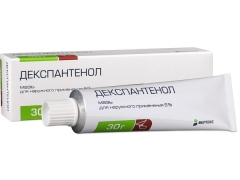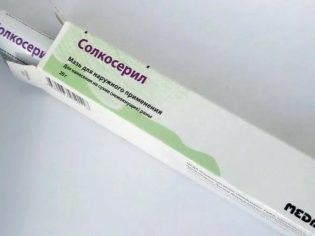Dexpanthenol for children
Dexpanthenol is one of the medicines used for various skin lesions. This medicine is in demand among young mothers, because it helps from cracks in the nipples. Can it be used in infants and how does this drug affect children's skin?
Release form
Dexpanthenol is produced in the form of 5% ointment, which is a light yellow thick mass, smelling of lanolin. Its shade can be darker (almost brown) and greenish. One aluminum tube holds 25 or 30 grams of such a substance.
Composition
The main component of the drug is called the same way as the drug itself - dexpanthenol. It is contained in 100 grams of ointment in the amount of 5 g. To make the preparation thick and well absorbed, liquid paraffin, emulsion wax, anhydrous lanolin, vaseline and other ingredients were added to the dexpanthenol.
Operating principle
In Dexpanthenol, the ability to stimulate tissue regeneration processes is noted. After application to the skin, the active substance of the drug is converted to pantothenic acid, which is actively involved in many metabolic processes. It stimulates the regeneration of skin cells and normalizes their metabolism, and also increases the strength of collagen fibers.
Indications
Use of Dexpanthenol is required for:
- Extremely dry skin.
- Different forms of dermatitis.
- Diaper rash.
- Burns
- Bedsores
- Various wounds.
- Cracks and scratches.
- Skin irritation due to sunlight, wind or frost.
Treatment with this ointment is recommended after surgeries on the skin, for example, after skin grafts or the opening of the boil. Nursing mothers use this medicine for inflammation or cracking of the nipples, as well as for the prevention of such injuries. In babies, Dexpanthenol helps prevent irritation from a diaper or diaper.
At what age is it allowed to take?
The use of Dexpanthenol for children is possible from birth. This drug is harmless to newborn babies and infants up to one year.
Contraindications
The drug can not be used in children with hypersensitivity to any of the components of the ointment. In addition, the treatment with Dexpanthenol is prohibited in case of weeping wounds.
Side effects
In very rare cases, treatment with Dexpanthenol can cause an allergic reaction.
Instructions for use
The drug is used only for external processing. Apply ointment to the damaged areas should be once a day or more often, if there are indications for this. For breast babies, medicine is applied to the skin after bathing or changing a diaper. Nipples of nursing moms are advised to lubricate after feeding, and before the next feeding the drug should be flushed.
Overdose and drug interactions
Cases of the negative effect of a large amount of ointment on the patient’s body, as well as incompatibility with other drugs, are not mentioned in the annotation.
Terms of sale and storage
Dexpanthenol can be purchased at a pharmacy without a prescription by paying about 100–120 rubles for a tube of 25 g of the drug. Keep the ointment at home should be at a temperature below +25 degrees. The medication should be in a place hidden from children. Shelf life of the drug is 2 years.
Reviews
In the majority of reviews of parents who used Dexpanthenol for various skin problems in children, there is a good healing effect of the drug.Moms are satisfied with the ease of use of the drug and safety for a child of any age. Also ointment is praised for low price.
Analogs
Instead of Dexpanthenol, you can use any other drug that contains the same active ingredient. All of them are allowed for toddlers of any age, moisturize the skin well, help get rid of prickly heat or irritation on the skin.
The most popular analogues of Dexpanthenol are:
- Bepanten.
- D-Panthenol.
- Panthenol spray.
- Pantoderm.
In addition, other drugs that have a similar effect on the skin, for example, Depantol cream, gel or ointment, may also be substituted for Dexpanthenol. Solcoseryl or cream Drapolen.
In the following video, Dr. Komarovsky gives advice on how to avoid diaper rash in babies.

























